Osuji Nwachukwu Joshua1, Callistus Chukwudi Ibe2, Geraldine Nkechinyere Okeudo2, Ejem Agwu Ejem3
1Department of Transport and Marine Management, Delta State University of Science and Technology, Ozoro, Delta State, Nigeria
2Department of Logistics & Transport Technology, Federal University of Technology Owerri, Imo State, Nigeria
3Department of Supply Chain Management, Federal University of Technology Owerri, Imo State, Nigeria
Correspondence to: Osuji Nwachukwu Joshua, Department of Transport and Marine Management, Delta State University of Science and Technology, Ozoro, Delta State, Nigeria.
| Email: |  |
Copyright © 2024 The Author(s). Published by Scientific & Academic Publishing.
This work is licensed under the Creative Commons Attribution International License (CC BY).
http://creativecommons.org/licenses/by/4.0/

Abstract
Marine routes may offer a safer means of transportation, reducing the risks associated with land-based convoys. Marine vessels can navigate through rivers and lakes, offering a faster and more efficient means of transporting relief materials compared to overland routes that may be congested or unsafe. The evaluation process involves the consideration of several subjective factors. The decision-making process is often intricate and occasionally marked by conflicting criteria, which presents a notable challenge. In contrast to the traditional method of selecting marine vessels for various tasks, the AHP-EDAS approach offers a more systematic means of identifying and evaluating the most suitable marine transportation vessel options for the efficient distribution of relief materials to the Damare IDP camp in northeast Nigeria. Within this investigation, it was determined that the primary criterion of utmost significance, with a priority value of 0.416 based on the AHP method, was the reliability and safety of the vessel option. Other criteria, such as operational cost, speed, fuel efficiency, route suitability/maneuverability, and serviceability, held values of 0.110, 0.098, 0.114, 0.172, and 0.090, respectively. The EDAS method was also employed in the evaluation and ranking of alternatives. Small catamarans were ranked as the best with an appraisal score of 0.9663 using the EDAS method, followed by the F-25 boat with an appraisal score of 0.9147, and the hovercraft boat was rated third with an appraisal score of 0.8476.
Keywords:
Marine Transportation, Inland water transportation, Vessel, Distribution of Relief Materials, AHP, EDAS
Cite this paper: Osuji Nwachukwu Joshua, Callistus Chukwudi Ibe, Geraldine Nkechinyere Okeudo, Ejem Agwu Ejem, Evaluating Suitable Marine Transportation Vessel Options for the Efficient Distribution of Relief Materials to the Damare IDP Camp in Northeast Nigeria, International Journal of Traffic and Transportation Engineering, Vol. 13 No. 2, 2024, pp. 23-30. doi: 10.5923/j.ijtte.20241302.01.
1. Introduction
A sustainable disaster supply chain has been the only viable way to mitigate the effects of spontaneous natural and man-made disasters that occur both quickly and slowly which includes saving lives, decreasing human suffering, and its need is so enormous notwithstanding its contribution to the field of disaster management [1]. In northeast Nigeria, over a ten-year humanitarian catastrophe has left 1.3 million men, 1.6 million women, 1.9 million boys, and 2.3 million girls in desperate need of aid [2].The Northeast region has been facing protracted humanitarian crises, including conflict and natural disasters, resulting in significant logistical challenges for the efficient and timely distribution of relief materials to the affected population. By investigating maritime transportation alternatives, one can potentially identify cost-effective and reliable solutions that can enhance the speed and effectiveness of relief operations, ensuring critical aid reaches those in need promptly. Moreover, the region's geographical constraints, limited road infrastructure, and security issues necessitate exploring alternative transportation modes like maritime routes, which could offer greater accessibility and resilience in the face of potential disruptions.Nigeria map showing the highly connected inland water that can be harnessed for national development is shown in Fig 1. 77.8% of Nigerian states can be accessed through the water while the remaining 22.2% cannot be accessed through the water [3]. With 77.8% of accessible navigational inland waterways routes, it’s important to incorporate Nigeria’s Inland Water transport system for optimal relief material distribution in northeast Nigeria. Furthermore, the inclusion of Nigeria’s inland waterway transport system in the relief material distribution channel will help in minimally reducing the pressure on other modes of transportation, especially roads in the transportation of heavy equipment and bulk goods both solid and liquid.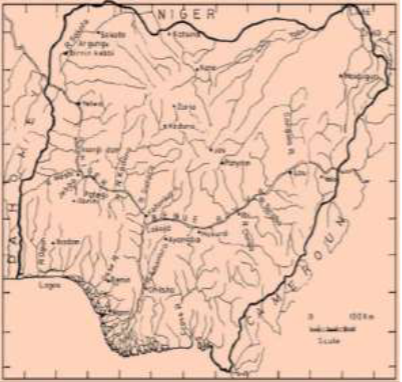 | Figure 1. A highly connected inland water for Nigeria National Development. (Source: [3], [4],[5]) |
Damare IDP camp can be accessed through the river Benue, as the Northeast Humanitarian Innovation Hub which serves as the central warehouse is along the same river Benue. This study will specifically concentrate on commonly utilized marine vessels and Damare camp with its proximity to the bank of river Benue.Ultimately, the research aims to contribute to more robust disaster response strategies and humanitarian efforts, saving lives and improving the overall well-being of vulnerable communities in Northeast Nigeria.Nigeria's most significant rivers are the Niger-Benue and the Chad rivers with few rivers which empties immediately into the Atlantic Ocean; all other waterways eventually empty into the Chad basin or the lower Niger to the sea [6] cited in [7].Equatorial Guinea, Chad, Niger, Cameroun, Benin, and Benin are among the five nations that Nigeria shares international borders with and they can be accessed through the inland waterway [8] cited in [3].The Nigeria Federal navigable inland waterways as captured by [8] are as follows:i. The River Niger from the Nigerian/Niger/Benin border, through the Nun and Forcados distributaries to the Atlantic Ocean.ii. The River Benue from the Nigerian/Cameroun border to its confluence with River Niger at Lokoja.iii. The Cross River from the Nigerian/Cameroun border to the Atlantic. Ocean, and all its distributaries.iv. Rivers Sokoto. Kaduna. Geriny. Gongola. Taraba. Donga. Katsina-Ala. Anambra. Ogun. Oluwa. Osse, Benin, Imo. Kwa Ibo.v. The Intra-coastal route from Badagry. along the Badagry Creek to Lagos through Lagos Lagoon to Epe, Lekki Lagoon to Iwopin. along Omu Creek, Talifa Kivei to Atijere, Akata. Aboto. Oluwa River to Okitipupa and to Gbekebo. Arogbo. Ofunama. Benin Creek to Warri. Also, the canal running from Araromi through Aiyetoro. Imelumo to Benin River and from Aiyetoro through Mahin Lagoon to Igbokoda.vi. The waterway from Warri along the Forcados River, through Frukana, Siama. Bomadi. Angalabiri. Patani. Torofani. down River Nun to Agberi, Kiama. Sabagreia. Gbaran Creek, Agudama, Ekpetional into Ekole Creek to Yanaka. Yenegoa, Sangala to Mbiakpaba. onto Okokokiri, Ofokpota, Olagaga. Nembe, Adema. Agoribiri Creek to Egbema, Degema, Sombreiro River to Hanya Town, Ogbakiri to Port Harcourt.vii. The waterway from Port Harcourt, through Amadi Creek down Bonny River, into Opobo Channel Adoni River, through Andoni Flats, Tellifer Creek, and Imo River. Shooter Creek. Kwa Ibo Creek, Kwa Ibo River, Stubbs Creeks. Widenham Creek, Effiat-Mbo Creek, Cross River estuary to Oron and Calabar.vii. Rivers Benin. Ethiope, Ossiomo. Onne, Aba. Azumini, Olomum. Siluko, Talifa, Forcados, Penington, Escravos, Warri, Ramos, Dodo, Bonny, Middleton, Fishtown, Sengana, Brass of Nicholas, Santa Barbara. San Batholomew, Sambriero, New Calabar, Mbo, Rio del Rey, Uruan, Akwayafe.ix. Creeks Odiama, Agamama Tora, Nembe, Krakama, Buguma, Bille, Finima, New Calabar, Ekole, Cawthprne Channel, Ikane-Bakassi, Omu, Kwato (Gwato), Adagbrassa, Chananomi, Okpoko, Jones Kulama, Ikebiri, Nikorogba, Sagbama, Egbedi, Kolo, Laylor, Hughes Channel.x. Lakes Mahin, Oguta, Osiam Ehomu.xi. The Orashi River from Oguta Lake to Ebocha, Omoku, Kreigani, Moiama., Okariki, Egbema, Sombreiro River.xii. Lake Chad, that part within Nigeria.The objective of this article is to evaluate suitable marine transportation vessel options for the efficient distribution of relief materials to the Damare IDP camp in northeast Nigeria using the enormous inland waterways in Nigeria.[9], integrated two multi-criteria methods of Best Worst Method (BWM) and Evaluation based on Distance from Average (EDAS) in solving the site selection problem. PESTLE (Political, Economic, Social, Technological, Legal, and Environmental) was considered to determine the optimal renewable energy consumption using fuzzy EDAS techniques [10]. [11], chose the optimal wastewater-reuse option based on the evaluation based on distance from the average solution for grey water (EDAS-G) after the criteria were weighed using the analytical hierarchy process (AHP) approach. [12], AHP weights the sustainable factors while using fuzzy EDAS and fuzzy Topsis for ranking of improvement set to determine application priority. Therefore, AHP and EDAS will be applied to evaluate suitable marine transportation vessel options for the efficient distribution of relief materials to the Damare IDP camp in northeast Nigeria.
2. Methodology
In this study, AHP and EDAS have been employed for the aim of ranking marine vessel alternatives concerning the precedence order in the criteria. AHP is used for the construction of an evaluation matrix while EDAS is used in calculating the weighted sum of PDA, normalized values of the weighted sum of the NDA, appraisal, and ranking of alternatives.
2.1. Analytical Hierarchy Process (AHP)
Practically, the applications of the AHP approach by [13] gave way to the introduction of the technique as a weight-estimating tool and a way for solving multi-criteria decision-making.With the help of matrices and linear algebra, the Analytic Hierarchy Process (AHP) is a multi-step decision analysis model known for transforming qualitative factors into quantitative measures where each criterion is given a weight that causes it to differ from the others based on importance, and this principle is used to assess alternatives [14].Determination of the relative importance of each pair of criteria in the same hierarchy is the first step in applying the AHP approaches, completing the pairwise comparison, and building of evaluation matrix. Table 1 shows the AHP scale used in this study.Table 1. Saaty's 1-9 Scale of Pairwise Comparisons
 |
| |
|
The steps involved in the AHP method are described as follows:Step 1: Construct a pair-wise comparison matrix of the chosen criteria using the AHP scale. If there is more than one expert involved in the pair-wise comparison exercise the average rating can be obtained using the formula below: | (1) |
Where ai = value estimated by expect for a criterion n = total number of experts involved in the pair-wise comparison exercise.Step 2: Representation of the average numerical value ratings in a crisp value matrixStep 3: Computation of criteria weights using Equation 2  | (2) |
Where n = Number of criteriaWj = The criteria’s weightaij = The entry in row I and colum j in the pair-wise comparison matrix for each criteriaN = Matrix ord
2.2. Evaluation Based on Distance from Average Solution (EDAS) Method
The EDAS method was developed by [15]. The approach is highly effective when dealing with conflicting attributes. It involves ranking alternatives by their proximity to the average solution. This is accomplished through two measures: Positive Distance from Average (PDA) Solution and Negative Distance from Average (NDA) Solution. The best alternative is determined by a high PDA value and a comparatively lower NDA value. The computation steps for the EDAS method are detailed as outlined in [15].Step 1: Choosing the criteria and the options, a decision matrix labeled as x is created, as depicted.; | (3) |
where denotes the performance evaluation of the particular alternative i on the criterion j. It is considered that all  are positive real numbers.Step 2: Calculating the average solution utilizing Equation (5) (6) across all criteria.
are positive real numbers.Step 2: Calculating the average solution utilizing Equation (5) (6) across all criteria. | (4) |
where m denotes the number of alternatives.Step 3: Compute the negative distance from the average solution (NDA) and the positive distance from the average solution (PDA) by utilizing Equations (5), (6), (7) and (8) respectively based on the beneficial and non-beneficial criteria. | (5) |
 | (6) |
 | (7) |
 | (8) |
where  and
and  respectively denote the sets of beneficial and non-beneficial criteria, and
respectively denote the sets of beneficial and non-beneficial criteria, and  represent a positive number.Step 4: Calculate the weighted sum of PDA,
represent a positive number.Step 4: Calculate the weighted sum of PDA,  and the weighted sum of NDA
and the weighted sum of NDA  , for all alternatives using a vector w
, for all alternatives using a vector w  comprising non-negative weights.
comprising non-negative weights.  | (9) |
 | (10) |
where  denotes the weight of the criteria.Step 5: Calculate the normalized values of the weighted sum of the NDA and the weighted sum of the PDA for evaluated alternatives through the utilization of Equations 11 and 12
denotes the weight of the criteria.Step 5: Calculate the normalized values of the weighted sum of the NDA and the weighted sum of the PDA for evaluated alternatives through the utilization of Equations 11 and 12 | (11) |
 | (12) |
where  and
and  respectively denote the normalized weighted sum of the NDA and the weighted sum of the PDA.Step 6: Calculation of the appraisal score
respectively denote the normalized weighted sum of the NDA and the weighted sum of the PDA.Step 6: Calculation of the appraisal score  for evaluated alternatives utilizing Equation (13).
for evaluated alternatives utilizing Equation (13). | (13) |
Step 7: Rank the alternative. The alternative possessing the greatest value of  is regarded as the most favorable.
is regarded as the most favorable.
2.3. Application of AHP – EDAS approach in Evaluate Suitable Marine Transportation Vessel Options for the Efficient Distribution of Relief Materials to the Damare IDP camp in Northeast Nigeria
This section examines the pertinent factors that should be taken into account for the best possible transportation of relief supplies to internally displaced persons camps in Northeastern Nigeria. These factors are based on variables that have a direct impact on the efficient transportation of relief materials and marine vessel transportation options, with inland navigable waterways serving as a crucial component of marine transportation that is utilised for the last-mile distribution of relief supplies to communities and IDP camps along the coastline or riverbanks.
2.4. Criteria Descriptions
The criteria are divided into two components Cost and Safety. However, there are six criteria to be considered which are Cost-effectiveness (C), Speed/Transit Duration (SP), Fuel Efficiency (FE), Route suitability/Maneuverability (RM), Reliability and Safety (RS), and Serviceability (S). Some of these criteria have both cost and safety components like Route suitability/ Maneuverability (RM) and Speed/Transit Durations. However, Cost-effectiveness (C), Speed/Transit Duration (SP), and Serviceability (S) are the cost components while Route Suitability/Maneuverability (RM), Speed/Transit Duration (SP), and Reliability and Safety (RS) are the Safety components of the criteria.
2.5. Vessels Alternative Descriptions
Nine marine craft alternatives that can operate in the northeast region of Nigeria were considered. The crafts have an average draft between 2meters to 5meters. Which gives them the advantage of operating in River Benue in northeast Nigeria. The following are the marine vessel alternatives been considered for the efficient and optimal distribution of relief materials:1. Automated Underwater Vehicle (AUV 2. Dinghies 3. Pontoon boat 4. Ferries 5. Hovercraft boat 6. Kayaks and Canoes 7. F-25 Boat8. Small Catamarans9. Tug Boat
3. Results and Discussions
3.1. Application of AHP for Criteria’s Weight Determination
Taking separate weights out, a pairwise comparison of criteria was carried out to evaluate suitable marine transportation vessel options for the efficient distribution of relief materials to the Damare IDP camp in northeast Nigeria.Three Experts were enlisted in this study to conduct the pair-wise comparison, and their involvement is presented in Table 2 used in developing a performance evaluation model that integrates various criteria. The AHP pairwise criteria performance design was done using Saaty's 1-9 Scale of Pairwise Comparison in Table 1.Table 2. Pairwise Comparison of Criteria
 |
| |
|
The weights of the criteria were calculated using Equation 2,  Where n is the matrix order, which is represented as 6, aij is the entry in row in the pair-wise crisp matrix for each criteria. The summation of the values obtained as the result of the division of each entry value in the column by the sum of the total entry value were multiplied by 1/6 which represented the matrix order to obtain the weight.Table 3 is a vessel criteria crip value matrix drawn from pair wise comparison of criteria table 2 as responded by each expert judgement. The sum of each column was computed.
Where n is the matrix order, which is represented as 6, aij is the entry in row in the pair-wise crisp matrix for each criteria. The summation of the values obtained as the result of the division of each entry value in the column by the sum of the total entry value were multiplied by 1/6 which represented the matrix order to obtain the weight.Table 3 is a vessel criteria crip value matrix drawn from pair wise comparison of criteria table 2 as responded by each expert judgement. The sum of each column was computed.
Table 3. Vessel’s Criteria Crip Value Matrix
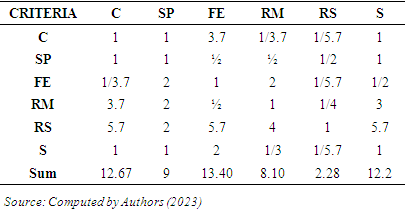 |
| |
|
3.2. Application of EDAS Method for Alternatives’ Evaluation and Ranking
The EDAS method employed the predetermined criteria weight obtained using the AHP method in the evaluation and ranking of the vessel alternatives for relief material distribution to the Damare IDP camp in northeast Nigeria. The average experts rating values were obtained as shown in Table (4)Table 4. Rating of Vessel alternatives
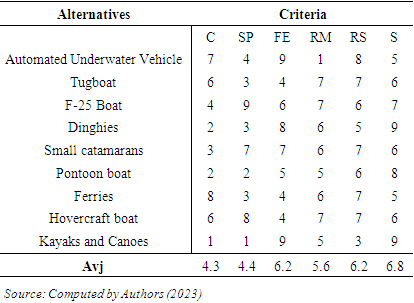 |
| |
|
The positive distance from the average rating value was determined for each alternative using Equation (9) for beneficial criteria by subtracting the average value from the rated value, the result was divided by the average value. Negative value as a result of the division was presented as zero (0). This was done for each column to obtain the result presented in Table 5.Table 5. Positive Distance from Average (PDA)
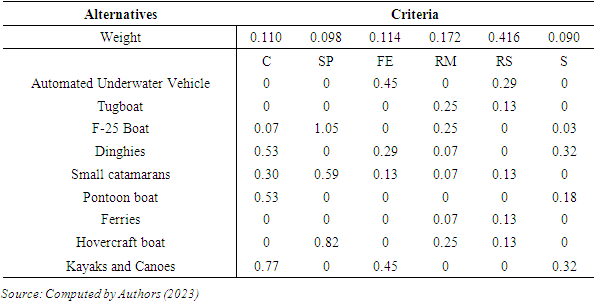 |
| |
|
For non-beneficial criteria (cost), the positive distance from the average rating value was determined for each alternative using Equation (10) by subtracting the rated value from the average value, the result was divided by the average value. Negative value as a result of the division was presented as zero (0).The weighted sum of the positive distance from the average rating value was determined for each alternative using Equation 11. The obtained values in each column were multiplied with their respective weights to obtain the results presented in Table 6. The Qi+ is the sum of all the values in the row.Table 6. Weighted Sum of PDA
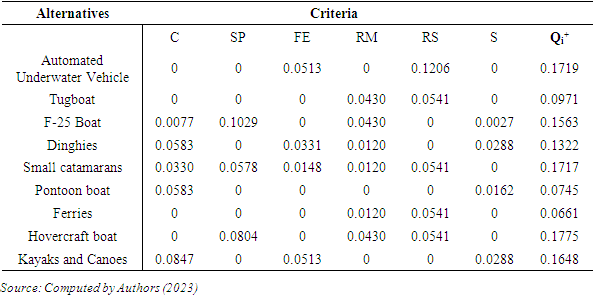 |
| |
|
The negative distance from the average rating value was determined for each alternative using Equations 7 for beneficial criteria by subtracting the rated value from the average value, the result was divided by the average value. Negative value as a result of the division was presented as zero (0). For non-beneficial criteria (cost), the negative distance from the average value was determined for each alternative using Equation 8 by subtracting the average value from the rated value, the result was divided by the average value. Negative value as a result of the division was presented as zero (0). This was done for each columns to obtain the result presented in Table 7.Table 7. Negative Distance from Average (NDA)
 |
| |
|
The weighted sum of the negative distance from the average rating value was determined for each alternative using Equation 12. The obtained values in each column were multiplied with their respective weights to obtain the results presented in Table 8. The Qi- is the sum of all the values in the row.Table 8. Weighted Sum of NDA
 |
| |
|
The normalization of the values of the weighted sum of the positive distance from the average rating value and the negative distance from the average rating value were determined using Equation 12 and Equation 13 respectively. The normalized value of Qi+was obtained by dividing each value of Qi+ by the maximum value of Qi+ in the column to obtain the value of Si+. The normalized value of Qi- was obtained by subtracting the value of Qi- from 1, and dividing it with the maximum value of Qi- to obtain the value of Si-.The appraisal score (Si) for all considered alternatives were obtained using Equation 13, by dividing the sum of Si+ and Si- by two. The alternatives were ranked based on decreasing values of the appraisal score as presented in Table 9 with Small catamarans toping followed by F-25 boat, hovercraft boat, Dinghies, Automated Underwater Vehicle, Tugboat, Pontoon Boat, Kayaks and canoes while the least in ranking alternatives are ferries.Table 9. Alternative Ranking
 |
| |
|
AHP pairwise comparison was used in the development of a performance evaluation model that integrates various criteria. However, reliable data and practical experience were both incorporated into the evaluation model to facilitate effective decision-making using the team of experts as in Table 2 and Table 3 respectively. EDAS was used in computing the average solution, computing the negative distance from the average solution (NDA) and the positive distance from the average solution (PDA), compute the appraisal score and finally rank alternatives with Equation 3 to 13.In addition, the various options assessed, small catamarans emerged as the most advantageous choice. They exhibited remarkable benefits compared to other alternatives, showcasing superior speed, fuel efficiency, dependability, and safety. The assessment involved a comparison of vessel alternatives based on six essential criteria: Operational Costs, Fuel Efficiency, Route Suitability and Maneuverability, Reliability and safety, Maintainability, and Speed. The findings of the assessment highlighted that Reliability & Safety and route maneuverability hold the utmost significance in selecting the appropriate vessel type for relief material distribution.
4. Conclusions
The AHP-EDAS methodology was employed this study was dedicated to evaluating the most suitable marine transportation vessel options for the efficient distribution of relief materials to the Damare IDP camp in northeast Nigeria. These methodologies encompass criteria selection, data collection, information integration, evaluation, and the assessment of vessel alternatives. The strength of these models lies in their capacity to analyze disparate, incomplete, and definite data from multiple information sources. The advantage of these integrated approaches is their ability to ensure reliable and consistent benchmarking. Moreover, the integrated approaches involved a panel of maritime transportation experts, whose active engagement contributes to a well-rounded consideration of requirements for both criteria and alternatives. Consequently, the proposed methodology surpasses conventional approaches to vessel selection.
References
| [1] | Cao, C., Li, C., Yang, Q., Liu, Y., Qu, T. (2018), A novel multi-objective programming model of relief distribution for sustainable disaster supply chain in large-scale natural disasters, Journal of Cleaner Production, 174(1), 1422-1435. https://doi.org/10.1016/j.jclepro.2017.11.037. |
| [2] | OCHA/ Eve Sabbagh (2018). Humanitarian Actions Analysing Needs and Response https://humanitarianaction.info/plan/869/ge/4985. |
| [3] | Osuji, J. N., & Agbakwuru, J. (2023a). Sustainable Inland Ports in Nigeria: An Opportunity for Growth of Nigerian Nation. J. Appl. Sci. Environ. Manage. 27 (5) 965-973. |
| [4] | Ezenwaji, E. E., Eduputa, B. M., Ogbuozobe, J. E. (2015). Employing water demand management option for the improvement of water supply and sanitation in Nigeria. J. Water Res. Protect. 7(8): 624. |
| [5] | Taiwo, AM; Olujimi, OO; Bamgbose, O; Arowolo, TA (2012). Surface Water Quality Monitoring in Nigeria. Situational Analysis and Future Management Strategy. In: Voudouris, Ed., Water Quality Monitoring and Assessment, InTech, London, 301-322. https://doi.org/10.5772/33720 http://www.intechopen.com/books/water-quality-monitoring-and-assessment/surface-water-quality- monitoring-in-nigeria-situational-analysis-and-future-management-strategy monitoring in Nigeria: Situational analysis and future management strategy. |
| [6] | USAID (2008), Nigeria Biodiversity and Tropical Forestry Assessment Maximizing Agricultural Revenue in Key Enterprises for Targeted Sites (Markets). |
| [7] | Osuji, J. N., & Agbakwuru, J. (2023b). Sand-Witched Plastic Wastes On Fibre-Glass-Reinforcement For Boat Building And Other Engineering Possibilities. Journal of Research and Innovation in Engineering, 7(1). |
| [8] | NIWA (n.d) (https://niwa.gov.ng/nigerian-waterways/). |
| [9] | Radwan, N. M., Elstohy, R., Hanna, W. K. (2021) A Proposed Method for Multi-Criteria Group Decision Making: An Application to Site Selection, Applied Artificial Intelligence, 35:7, 505-519, DOI: 10.1080/08839514.2021.1901031. |
| [10] | Demirtas, O., Derindag, O.F., Zarali, F., Ocal, O., Aslan, A. (2021). Which renewable energy consumption is more efficient by fuzzy EDAS method based on PESTLE dimensions? Environ Sci Pollut Res, 28(1), 36274–36287. https://doi.org/10.1007/s11356-021-13310-0. |
| [11] | Parisa, P., Ashofat P. S., Loaiciga A. H. (2021). Integration of Gray System Theory with AHP Decision-Making for Wastewater Reuse Decision-Making. Journal of Hazardous, Toxic, and Radioactive Waste, 24(1), https://doi.org/10.1061/(ASCE)HZ.2153-5515.0000619. |
| [12] | Hichem, A., Mohyeddine, S., Abdessamed, K. (2022), "Benchmarking framework for sustainable manufacturing based MCDM techniques", Benchmarking: An International Journal, Vol. 29 No. 1, pp. 87-117. https://doi.org/10.1108/BIJ-08-2020-0452. |
| [13] | Saaty, T. L. (1980). The Analytic Hierarchy Process. Mcgraw-Hill, New York. |
| [14] | Sachin, S. (2023, June 3). Multi-Criteria Decision-Making Using AHP in Python. analyticsvidhya https://www.analyticsvidhya.com/blog/2023/05/multi-criteria-decision-making-using-ahp-in-python/. |
| [15] | Ghorabaee, M. K., Zavadskas, E. K., Olfati, L., Turskis, Z. (2015). Multi-Criteria Inventory Classification Using a New Method of Evaluation Based on Distance from Average Solution (EDAS). INFORMATICA, 26(3), 435–451 4. DOI: http://dx.doi.org/10.15388/Informatica.2015.57. |







 are positive real numbers.Step 2: Calculating the average solution utilizing Equation (5) (6) across all criteria.
are positive real numbers.Step 2: Calculating the average solution utilizing Equation (5) (6) across all criteria.




 and
and  respectively denote the sets of beneficial and non-beneficial criteria, and
respectively denote the sets of beneficial and non-beneficial criteria, and  represent a positive number.Step 4: Calculate the weighted sum of PDA,
represent a positive number.Step 4: Calculate the weighted sum of PDA,  and the weighted sum of NDA
and the weighted sum of NDA  , for all alternatives using a vector w
, for all alternatives using a vector w  comprising non-negative weights.
comprising non-negative weights. 

 denotes the weight of the criteria.Step 5: Calculate the normalized values of the weighted sum of the NDA and the weighted sum of the PDA for evaluated alternatives through the utilization of Equations 11 and 12
denotes the weight of the criteria.Step 5: Calculate the normalized values of the weighted sum of the NDA and the weighted sum of the PDA for evaluated alternatives through the utilization of Equations 11 and 12

 and
and  respectively denote the normalized weighted sum of the NDA and the weighted sum of the PDA.Step 6: Calculation of the appraisal score
respectively denote the normalized weighted sum of the NDA and the weighted sum of the PDA.Step 6: Calculation of the appraisal score  for evaluated alternatives utilizing Equation (13).
for evaluated alternatives utilizing Equation (13).
 is regarded as the most favorable.
is regarded as the most favorable. Where n is the matrix order, which is represented as 6, aij is the entry in row in the pair-wise crisp matrix for each criteria. The summation of the values obtained as the result of the division of each entry value in the column by the sum of the total entry value were multiplied by 1/6 which represented the matrix order to obtain the weight.Table 3 is a vessel criteria crip value matrix drawn from pair wise comparison of criteria table 2 as responded by each expert judgement. The sum of each column was computed.
Where n is the matrix order, which is represented as 6, aij is the entry in row in the pair-wise crisp matrix for each criteria. The summation of the values obtained as the result of the division of each entry value in the column by the sum of the total entry value were multiplied by 1/6 which represented the matrix order to obtain the weight.Table 3 is a vessel criteria crip value matrix drawn from pair wise comparison of criteria table 2 as responded by each expert judgement. The sum of each column was computed.
 Abstract
Abstract Reference
Reference Full-Text PDF
Full-Text PDF Full-text HTML
Full-text HTML







